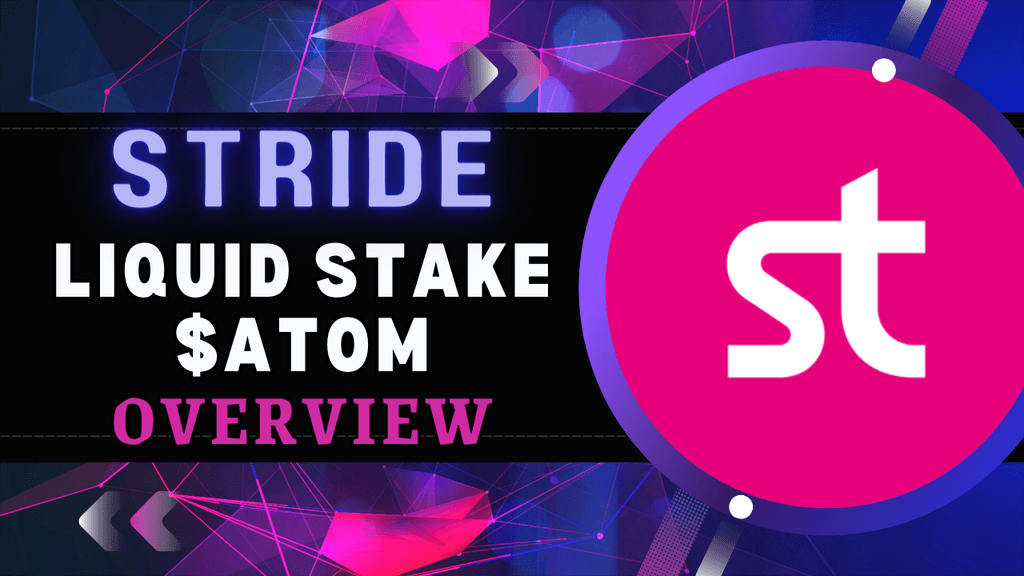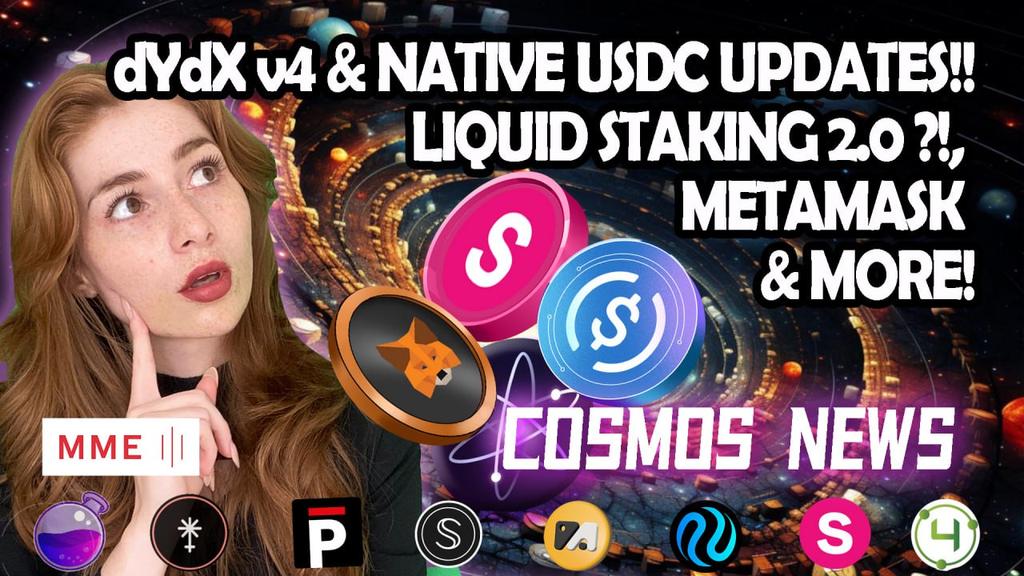Stride: An Introduction
Stride is a liquid staking protocol designed for the Cosmos blockchain ecosystem. It enables users to unlock liquidity and earn yield on their staked assets without the need to stake them directly, allowing them to participate in DeFi while simultaneously earning staking rewards. Built using the Cosmos SDK and Tendermint, Stride offers a secure and minimalist blockchain solution, focusing primarily on its core liquid staking protocol. It has garnered a significant market share within the Cosmos ecosystem, supporting numerous Cosmos Zones through the Inter-Blockchain Communication (IBC) protocol.
Stride’s core philosophies are minimalism and credible neutrality. The platform is designed to do one thing exceedingly well: liquid staking. It accomplishes this through a minimalist approach, reducing potential vulnerabilities and making the chain more resilient and secure. Stride is also neutral, providing services across multiple chains without favoritism or bias, thus adhering to the ethos of decentralization. Inspired by the design principles of the Cosmos Hub, Stride is poised to be a key player in the Cosmos ecosystem, facilitating liquid staking for the next generation of Cosmos chains.
Liquid Staking Explained
Liquid staking is a novel approach to participating in proof-of-stake (PoS) blockchain networks. In traditional staking, users lock up their tokens to support the network’s security and consensus mechanism, earning staking rewards in return. However, during the staking period, these tokens become illiquid and cannot be used for other purposes. Liquid staking addresses this limitation by introducing a mechanism where staked tokens are “wrapped” or represented by liquid, tradable tokens. These tokens represent the staked tokens that can be freely transferred, traded, or utilized in DeFi applications while still earning staking rewards. Liquid staking enables users to enjoy the benefits of staking rewards without sacrificing the liquidity and flexibility of their tokens, unlocking their value for various financial activities within the blockchain ecosystem.
When a user decides to liquid stake with Stride, they send their token to the protocol, and then the protocol stakes these tokens on behalf of the user. In return, the protocol mints an equivalent amount of stTokens and assigns them to the user’s wallet. These stTokens represent the staked tokens and are freely transferable and tradable. As the staked tokens earn staking rewards, the rewards are automatically compounded and reflected in the value of the stTokens. The more staking rewards accumulate, the more the stTokens appreciate in value, offering users a dynamic asset that reflects both the underlying staked tokens and the earned rewards. When a user wishes to access their original staked tokens, they can “unstake” by redeeming their stTokens for the underlying tokens at any time. Liquid staking thus provides users with the best of both worlds, enabling them to earn staking rewards while having the freedom to use their tokens in other DeFi applications or trade them on the market.
Supported Blockchains and Integrations
Supported LSD Tokens
As of Feb 13, 2024, Stride’s liquid staking protocol currently supports an array of tokens from different blockchains within the Cosmos ecosystem. Users can stake their:
- Cosmos Hub tokens (stATOM)
- Celestia tokens (stTIA)
- Comdex tokens (stCMDX)
- dYdX tokens (stDYDX)
- Osmosis tokens (stOSMO)
- Juno tokens (stJUNO)
- Stargaze tokens (stSTARS)
- Evmos tokens (stEVMOS)
- Terra 2 tokens (stLUNA)
- Injective tokens (stINJ)
- Umee/UX tokens (stUMEE)
- Sommelier tokens (stSOMM)
- Saga tokens (stSAGA)
- with the intention to onboard most Cosmos chains in the future.
AEZ Integration via ICS
On June 13, 2023, the Stride blockchain adopted interchain security (ICS) through Cosmos Hub proposal 799, enhancing its economic security from $25 million to about $2.3 billion. The transition, formalized on July 19, shifted Stride’s block production from its validator set to Cosmos Hub’s, with Stride’s governance still driven by the STRD token, which continued to offer staking rewards and voting rights on governance issues. Validators became “governors,” no longer needing to run nodes but remaining integral to the ecosystem. The move also involved halving STRD staking rewards and sharing 15% with Cosmos Hub, while maintaining operations of liquid staking, IBCing, and airdrops on Stride. This transformation strengthened Stride’s resilience against economic attacks and is anticipated to boost confidence from large investors, DAOs, and institutions.
Tokenomics
Stride’s tokenomics is designed to achieve three main goals: quickly and effectively distribute governance power across the communities it serves, facilitate social coordination to promote Stride liquid staking, and build and maintain value for the STRD token.
The token allocation at genesis includes a circulating supply of 9,200,000 STRD out of a maximum supply of 100,000,000 STRD. The supply will be distributed to various categories, including airdrops to ATOM, OSMO, and JUNO stakers, staking rewards for STRD stakers, community incentives to promote Stride liquid staking, a strategic reserve, allocations to core contributors and partners, and more.
Token emissions occur through block-by-block emissions, incentives distribution, and vesting to core contributors and partners. Block-by-block emissions will reduce by 50% each year until they reach zero. The incentives distribution will be decided by the Stride DAO, while vesting tokens are linearly vested over two years with a one-year cliff.
Recently, there have been updates to the protocol revenue and STRD emissions, allowing STRD stakers to handle revenue and potentially increasing emissions to meet the original year-end target. Overall, Stride aims to be a community-driven liquid staking provider with sustainable revenue and strong governance facilitated by its native token, STRD.
Sustainability and Incentive Program
Stride’s incentive program is an essential feature of its ecosystem, designed to promote and sustain trading liquidity for stTokens on various Decentralized Exchanges (DEXes) throughout the Cosmos. The program incentivizes stToken holders and liquidity providers by offering them rewards in the form of Stride’s native token, STRD, and various other tokens. These incentives are especially relevant as Stride expands its array of stTokens, with nine different stTokens currently available, most of which are paired with at least one incentivized liquidity pool.
The incentive program operates in 30-day cycles, with forward guidance provided to stToken holders and liquidity providers to ensure transparency and prevent surprises. Recently, the program has diversified to include non-STRD tokens, thanks to a decision by Stride governance to diversify the STRD incentive pool. This move, which involves swapping STRD for other tokens, such as USDC in Over-The-Counter (OTC) deals, reduces STRD emissions and aids in the program’s sustainability. As of the fourth iteration of the incentive program, Stride is achieving an increasingly sustainable model of stToken trading liquidity, ensuring a more secure, useful, and user-friendly liquid staking experience.
Inclusive Validator Sets
Stride has a crucial role in curating host-chain validator sets which directly impacts the decentralization of the blockchains it serves. The curation is driven by STRD holders and key Cosmos community members, reflecting Stride’s belief in decentralization ethos. As a liquid staking provider, Stride has a significant influence on the decentralization of supported blockchains, with a higher Nakamoto Coefficient signifying greater decentralization. It is essential to ensure the quality of validators as they can differ in their reliability, contribution to the ecosystem, and commission rates.
The Stride community curates the host-chain validator sets through on-chain governance, where STRD tokens are used for voting. This ensures that Stride’s inclusive validator sets, where any validator can be included, reflects the voice of the community. The weight assigned to each validator depends on the Stride community’s decision, which could be influenced by factors like contributions to the ecosystem, previous slashing events, and voting history. All information, including how adjustments would change the Nakamoto Coefficient and details about each validator, will be made easily understandable for the STRD holders to make informed governance decisions.
While other models like the intents based model were considered, the current inclusive validator set method was deemed the safest and most effective. If a better method arises, the community can pass a signaling proposal for implementation by Stride contributors.
Security
Stride is a secure minimalist blockchain, with no smart contracts and no other apps beside the core liquid staking protocol. The Stride codebase has been fully audited by numerous security firms, and receives continuous auditing from Informal Systems, a leading expert on the Cosmos SDK and IBC. And the Stride blockchain is protected by IBC rate-limiting.
Stride security is powered by a combination of:
- Minimalistic design at its core: small attack surface, fewer moving parts means fewer edge cases to consider
- Proof-of-stake decentralized Tendermint consensus
- On-chain fail safes that monitor and mitigate malicious behavior
- IBC rate limiting limits how much can be IBC transferred over a time period
- Rigorous point-in-time audits: Informal Systems (2x), Oak, Certik
- Ongoing quarterly audits from Informal Systems
- Incredibly rigorous SDK testing processes
- Novel interchain testing suite
- Bug bounties. Immunefi onboarding in process for $500k bounty, one of the largest in the space
- Highest economic security in Cosmos; Interchain Secured by the Cosmos Hub
Future Developments and Roadmap
For the upcoming period, Stride intends to fortify its security measures through methods such a continuous auditing, and introducing a robust bug bounty. The concept of Liquid Governance is also being developed to enable stToken holders to exercise the voting power of their underlying tokens. This will be initiated with Planetary Governance on the Stride blockchain and will gradually expand to Orbital Governance on Osmosis Liquidity Pools, and eventually, Cosmic Governance throughout the Cosmos.
To make the protocol more user-friendly, Stride plans to roll out the Infinity Pool for effortless liquid staking, the Interchain Autopilot to simplify the staking process, and the Liquid Staking Module for direct staking. Stride also aims to make data more accessible to users through various dashboards. In terms of core research, Stride will explore innovative features like Bonded Liquidity Market for instant redemptions, Protocol-Owned Arbitrage for treasury enhancement, and Yield Indices for delegate preferences. Plans are also underway to extend the reach of stTokens to Ethereum, NEAR, and Polkadot, and to introduce staking tokens of non-Cosmos PoS Chains.










